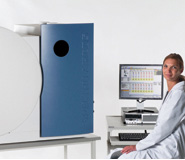The JAIMA EXPO 2010 opens its doors in Tokyo today - and we're looking forward to presenting the SPECTRO ARCOS 165, the newest model in our ICP-OES series at this leading Japanese tradeshow.
With its high precision, excellent detection limits and outstanding reproducibility, the SPECTRO ARCOS 165 is well suited to applications in environmental analysis - and as a midrange offering, rounds out our ICP-OES portfolio between the entry-level SPECTRO GENESIS and the flagship SPECTRO ARCOS.
 The SPECTRO ARCOS 165 ICP-OES
The SPECTRO ARCOS 165 ICP-OES
The new model is based on the high-end components in the SPECTRO ARCOS. The only difference between the two being their optics: While the ARCOS records the spectrum between 130nm and 770nm with every measurement, the trimmed down optic in the ARCOS 165 measures the wavelength range between 165 and 770 nanometers.
For you, this means that, as long as you do not need to conduct high performance halogen analysis, you can now get the same capabilities as the original ARCOS for a much lower price!
Technical highlights for the SPECTRO ARCOS 165 include:
- the optic with a resolution of 8.5 picometers
in the wavelength between 165 and 340 nanometers and 15 picometers in the range between 340 to 770 nanometers.
- its unshakeable, free-running 27 MHz generator providing a stable excitation source. With 5 kilowatt input power, it has more than enough power to insure stable analysis of even the most difficult matrixes.
- the argon circulating optic saves more than $2,000 per year in operating costs
- our proven, user-friendly Smart Analyzer Vision (SAV) analytical software is fully compatible with all environmental analysis protocols, including the USEPA Contract Laboratory Program (CLP) guidelines.
Important for daily use: The SPECTRO ARCOS 165 is optimized for unattended laboratory operation - and automatically measures up to 80 samples per hour. The instrument is an excellent choice for small and large laboratories that require the ultimate in performance and reliability. From percent levels to ppb, the ARCOS provides the rugged reliability necessary to maintain productivity in the most demanding environments.
Sound good?